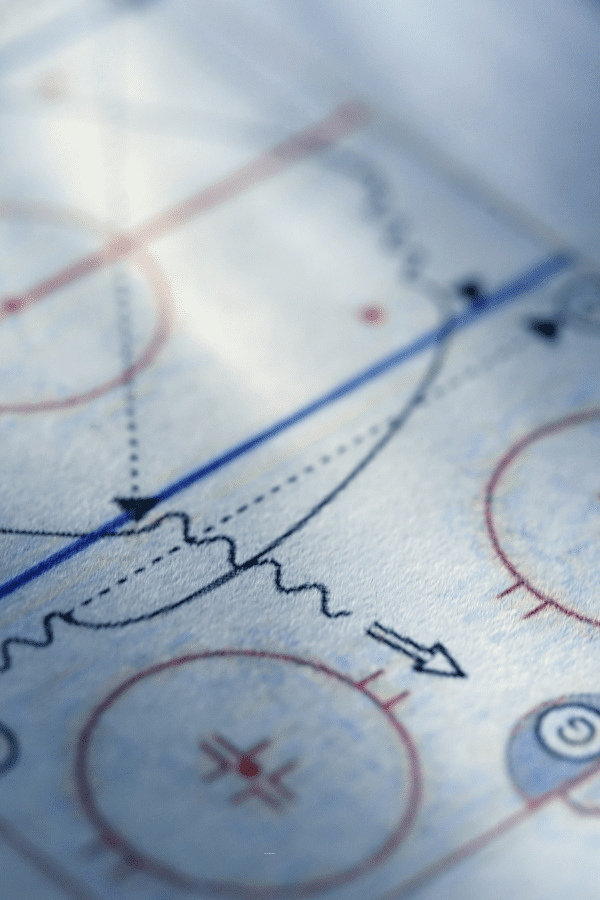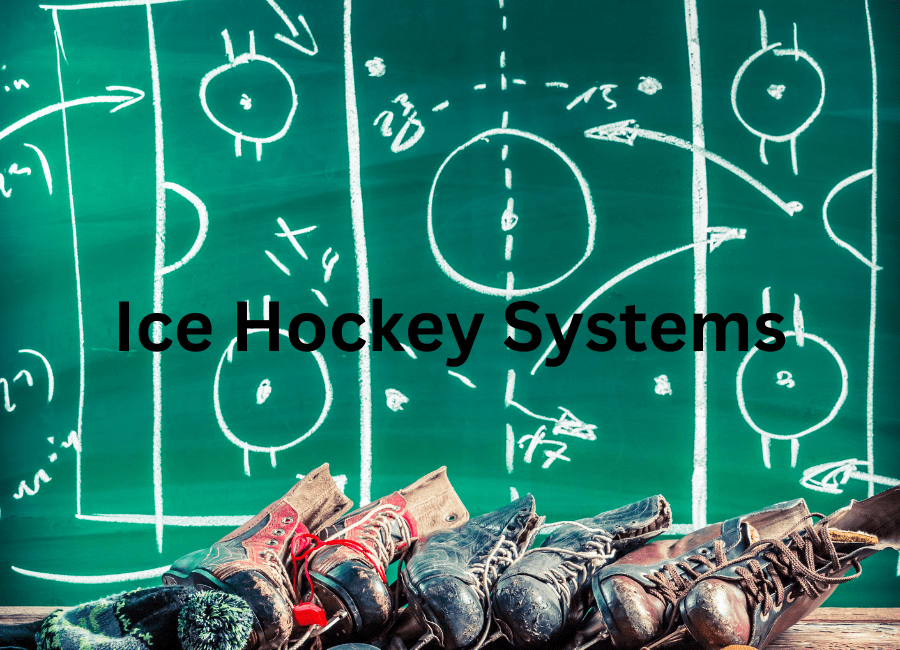Ice hockey systems refer to the organized plans, strategies and tactics that a team uses to play in different areas of the ice. These systems are designed to help players know where to position themselves, how to move, and what to do depending on whether their team has the puck (offense) or is defending (defense). Think of systems as a “game plan” that ensures everyone is on the same page during a game.
There are three main areas where ice hockey systems are applied:
- Offensive Zone Systems: These are strategies used when your team is trying to score a goal. For example, players may focus on cycling the puck (passing it around in circles) to tire out the defenders or positioning someone in front of the net to block the goalie’s view.
- Defensive Zone Systems: These strategies focus on protecting your goal. Players are positioned to block shots, cover opposing players, and clear the puck from dangerous areas. Think of it like setting up a wall in front of your goalie to prevent the other team from scoring.
- Neutral Zone Systems: This is the area between the two blue lines (center ice). Neutral zone systems help teams stop the other team from getting into their offensive zone, forcing turnovers, and preparing for a counter-attack. It’s all about keeping control of the puck and blocking the other team’s path.
In simple terms, these systems help players understand their roles on the ice, making sure everyone works together as a unit to play effectively. Whether it’s offense, defense, or transitioning between the two, having a clear system helps teams function smoothly.

Ice Hockey Systems vs. Special Teams: A Comparison
In ice hockey, systems refer to the overall tactics a team employs during regular play, focusing on maintaining structure and organization in different zones of the ice. For example, teams may use a 1-2-2 defensive zone system or a forechecking system to regain control of the puck. These systems define how the entire team moves and operates together during regular 5-on-5 play, with an emphasis on positioning, puck movement, and player responsibilities(Pure Hockey (Blue Seat Blogs).
On the other hand, special teams come into play during specific game situations like power plays and penalty kills, where one team has a player advantage or disadvantage due to penalties. Special teams require different strategies than regular systems, focusing on maximizing scoring chances during a power play or preventing goals while shorthanded during a penalty kill (Fresh Gear) (Ice Hockey Systems Inc.).
While both systems and special teams are integral to a team’s success, they serve distinct purposes. Regular systems are designed to ensure consistent performance across all scenarios, while special teams focus on critical, game-changing moments. For youth hockey, understanding both systems and special teams is important, but the emphasis may shift as players develop—focusing more on foundational systems at a young age and introducing special teams tactics as they progress(Minnesota Hockey)
Resources for Players and Coaches:
- Players can focus on drills like “Shooting Off the Pass” to work on puck handling and quick release under pressure(Ice Hockey Systems Inc.).
- Coaches can access systems-based drills such as 3v3 scoring games to enhance offensive creativity(Ice Hockey Systems Inc.).
2. Defensive Zone Systems:
Defensive zone systems, such as the “Standard D-Zone Coverage,” prioritize protecting the area in front of the net (the “house”) and clearing pucks out of the zone. Man-to-man or zone defenses are common, where defenders focus on maintaining coverage and blocking passing lanes to prevent scoring opportunities. Communication and positioning are critical for an effective defensive structure Ice Hockey Systems Inc.
Resources for Players and Coaches:
- Players should practice gap control and backchecking drills to improve defensive coverage and minimize scoring chances(Ice Hockey Systems Inc.).
- Coaches can utilize layered defensive coverage drills to teach proper positioning and clearing techniques(Ice Hockey Systems Inc.).
3. Neutral Zone Systems:
The neutral zone is critical for transitioning between offense and defense. Systems like the 1-2-2 or trap formations are often used to disrupt the opponent’s breakouts and regain possession. Effective neutral zone play requires players to maintain good spacing, support each other, and communicate effectively to prevent the opposing team from entering the offensive zone with speed(Elite Hockey Canada), Ice Hockey Systems Inc.).
Resources for Players and Coaches:
- Players can focus on regrouping drills that emphasize puck control and speed through the neutral zone(Elite Hockey Canada).
- Coaches should implement drills that simulate neutral zone forechecking to teach players how to maintain pressure and force turnovers(Ice Hockey Systems Inc.).
These systems are integral for a team’s success, whether at a youth or elite level. Coaches and players can find extensive resources on platforms like Ice Hockey Systems, which offers detailed drills and strategies for improving play in all three zones(Ice Hockey Systems Inc.)
Ice hockey systems are like the playbook for how a team operates on the ice. Whether it’s in the offensive zone where the goal is to score, the defensive zone where the team protects their net, or the neutral zone where they try to control the flow of the game, systems help players work together smoothly.
These strategies ensure that everyone knows where to be and what to do, helping teams perform better and win more games.
Even if you’re new to hockey, understanding these systems can give you a clearer picture of how the game unfolds and how teams make strategic decisions.




Pingback: Why Are Hockey Shifts So Short? - Ice Hockey Moms
Pingback: Understanding the Game: What are Points in Hockey? - Ice Hockey Moms
Pingback: Dimensions of a Hockey Net - Ice Hockey Moms